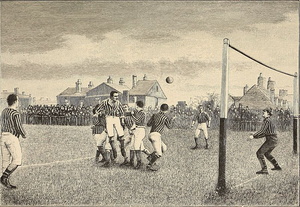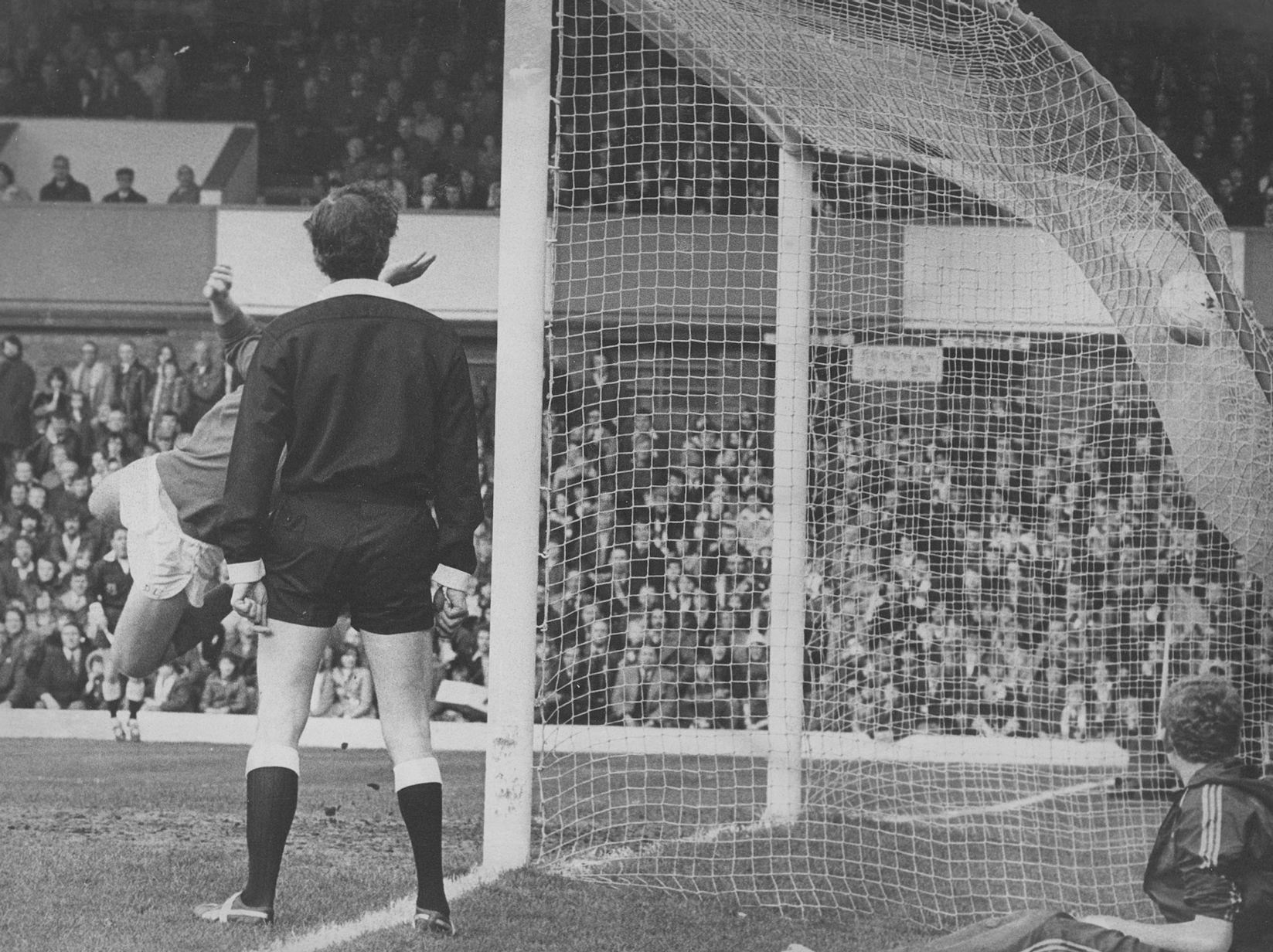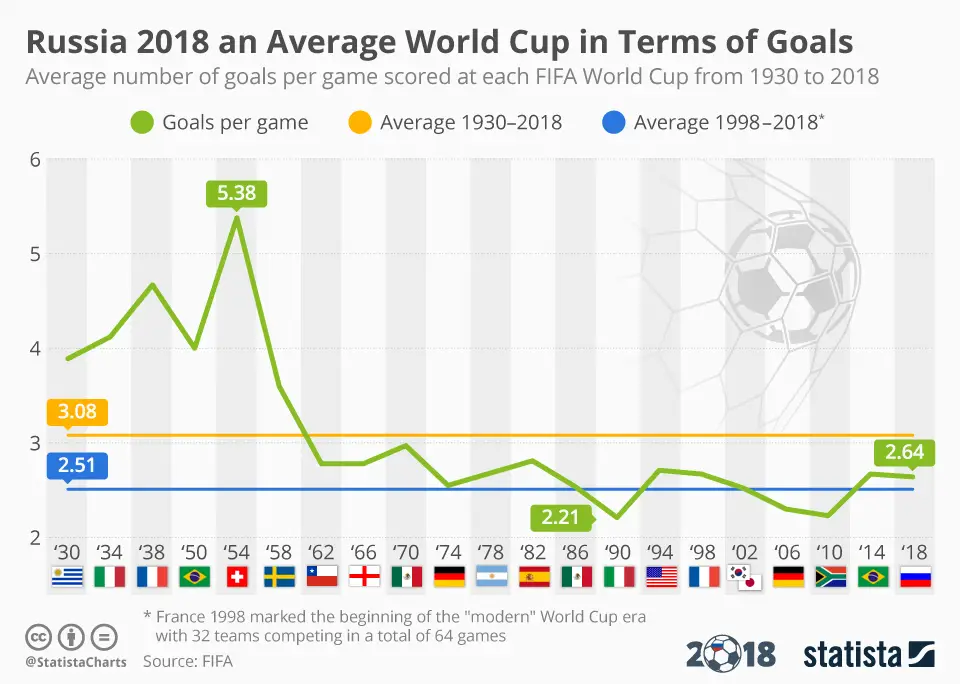In 1996, FIFA proposed the controversial idea of increasing the size of football goals to boost the number of goals scored in matches. It was panned across the board as a poor idea, despite the plan having Sepp Blatter’s backing.
You may also scoff at the notion, but it was genuinely a possibility following the World Cup in America. Maybe they just wanted to ensure an incident like Diane Ross’ miss in the opening ceremony never happened again, but Blatter and many American backers were keen to push the proposal through.
The plan may never have gotten any closer to seeing the light of day than Kick-ins, once trialled in the second division of Belgium around the same time, but when first suggested, goals per game had been slowly declining for years.
In order to understand why such a proposal would be made, and why it was met with such a poor response, it’s important to understand the history of goals in football, and how far we’ve come from the fledgling years of association football.
The History of the Goal
Now, football is a very old game, much older than some give it credit for, but for the sake of this article we can consider football as we know it to first exist in 1863. There of course had been many many iterations of football like sporting events and games, the earliest example of which dating as far back as 2,500 BC China. But in 1863, the Football Association or the FA formed in England.
Goal sizes had fluctuated before the formation of the FA, with height almost never considered as an issue. By that I mean there was no notion of a cross bar, nothing could go over. There was only wide. There were at least rudimentary posts marking the width of goals and in 1863 the FA would officially dictate that a goal should be 24 feet wide, a decree that has stood the test of time, with goals still the same width.
Solved By Crossbar
As there was a lack of any specification of height, goals were often counted despite being 20 metres in the air. Even if we consider that normal, it would lead to many disputes of what was in and what was wide, with no way to tell. Football very much resembled a kick-about amongst kids in the park at this point.
Naturally, this couldn’t go on, but it would take almost 20 years before cross bars were made compulsory. Before this clubs would use tape or string, but some would simply choose not to bother.
Sheffield United claim to be the first club to use Crossbars as we know it, with trials for this new-fangled technology undergoing in the 1870’s. This claim is however, disputed by Scottish side Queens Park who themselves boast of being the first.
In 1882 cross bars were made compulsory, as football very much resembled the sport we see today. The game had evolved. Now goals could always be given correctly and there was a complete departure from the days of disputing what was in and what wasn’t, as solid posts would mark the start of a new era of certainty. Right?
Of course, it would not provide 100% certainty, but the Crossbar would solve many of football’s issues. Yet despite a clear goal, many big games amongst national teams would be sullied by disagreement. Anybody who has played a football match with net-less goals, will be well aware that in the heat of the moment it’s very easy to lose track of what went off target and what didn’t.
Brodie’s Trouser Net
John Brodie’s trousers would inspire the solution to this persistent issue in football. The engineer from Liverpool aimed to eradicate disputes by inventing “a huge pocket.” In 1891, he finished his prototype, leading to the trial of goal nets in Nottingham.
Disputes in football were ended and never again would a goal be given or awarded wrongly. That might have been how football’s future seemed to the players and fans at the time, but we know that even with video technology goals have been wrongly awarded or disallowed.
Little would change would trouble Goalmouths for almost a hundred years, until FIFA was forced to ban square posts in 1987, with multiple controversies over the years prior involving shots that may have gone in had the woodwork been rounded. Consistency is of course what football strives for from a regulatory standpoint, and this change once again has only brought less controversy.
As we reach the end of this foray into the goals of football, an important question rises. Where does our enjoyment come from in Football? The drama and passion certainly, but at the heart of much of football’s most celebrated dramatic finales is controversy and unrest amidst the affected fans.
This is where I’d like to segue back into the initial topic at hand.
Joseph Blatter and The Goal Size Extension
It was an idea born out of the aforementioned decrease in goals scored. Using average goals scored per game in each World Cup as a means to test this hypothesis, it becomes immediately apparent that after peaking at 5.4 in 1954, average goals per game had fallen to 2.71 in 1994, with a measly, still record low 2.21 at Italia 90.
The obvious factor in this decline is the tactical evolution, with football in the 50’s being a far more rudimentary game, in which the lack of tactical understanding at the time greatly benefitted Forwards over Defenders.
A decline in goals is reluctant of everyone not just being better players, but having a much richer understanding of the tactical and mental side of the game. So, with an emerging American audience for football, following the 1994 World Cup, Blatter is very keen to increase goals scored.
More goals = more excitement, in his mind at least. It’s not possible to increase goals scored without a radical rule change, but a new game changing rule would be dismissed and changes to existing rule would either be insufficient or once again too big a change.
Increasing the goal size could just possibly work, in the eyes of Blatter. There is some logic behind this proposed plan too. Goalkeepers are on average a whole foot taller (6 ‘3) in 2023 than when the goals height and width was first clarified in 1882.
The proposal would be to increase the width by 18 inches and the height by nine inches, or two footballs, surely fixing the low scoring nature of the game.
The Response
Obviously, the proposal was laughed out of proceedings, the idea quickly torn to shreds. Critics of the proposal argued that making the goals bigger would fundamentally change the game and could lead to a decrease in match quality. “The reaction was such that the board felt it was inappropriate to even consider the matter in more detail,” said board member Graham Kelly of England
The proposal was eventually put to a vote at the FIFA Congress in 1997, but it was ultimately rejected by a majority of the delegates. It was a disappointment for Blatter, unable to stake a monumental change in the world’s most beloved sport.
It was frustrating for the MLS who had been lobbying for the plan and were keen to trial the adaptation in the States, perhaps kickstarting country-wide interest in the club level of the game.
As football today faces many proposals, some inconvenient others, like the Super League potentially uprooting the very foundries of football, it’s important to remember that manufactured or encouraged excitement is almost always unsatisfying.
The beauty of football comes from the fact that goals so drastically change games. It comes from the struggle to get a goal. Had Blatter got his way much of the drama that makes football so all consuming would surely have been stripped, replaced by a substitute filled with cheap thrills.
Ironically, at the same committee, Blatter, when explaining the decision to forgo technology and helping football evolve in it’s quest consistent regulation would be quoted as saying “The board knows about existing technology. But football is played everywhere and we have to have one law for the game. We can’t have one law for those who can afford technology and another for those who can’t.”









